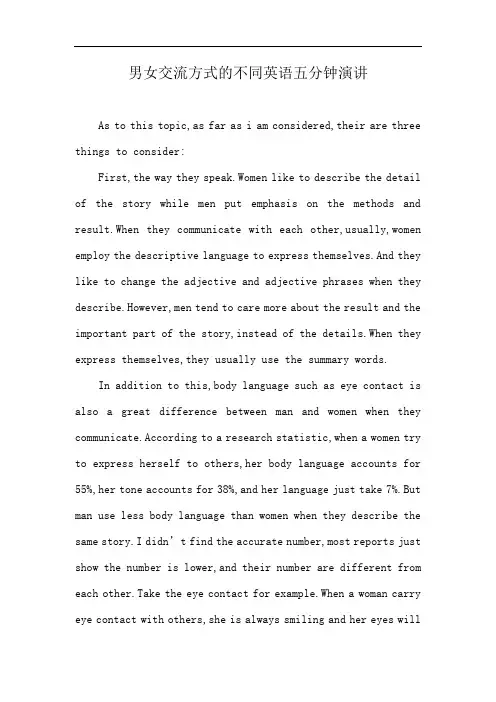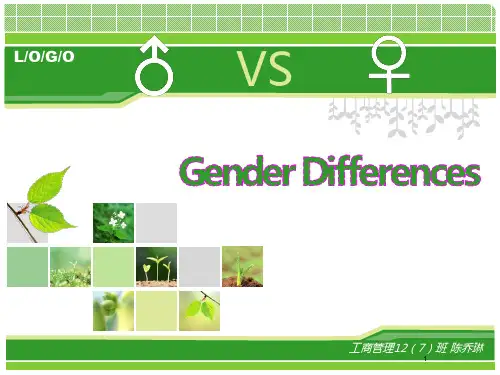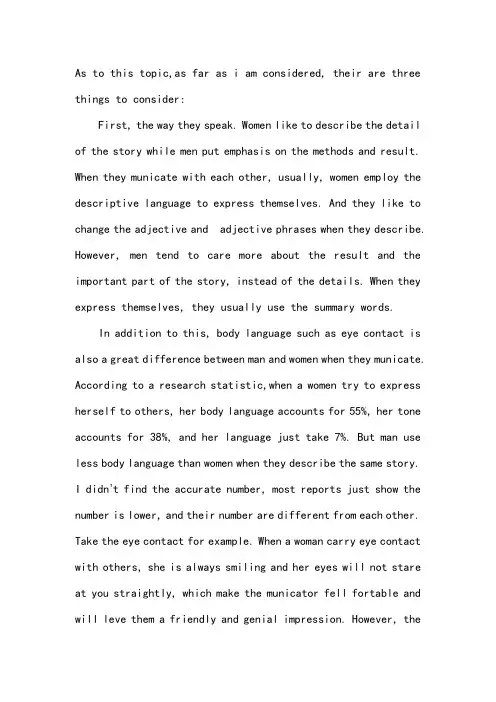英语ppt 男女说话方式的不同
- 格式:ppt
- 大小:858.50 KB
- 文档页数:9



英语口语语言技能应用的性别差异IntroductionIn recent years, more and more people have realized the importance of English proficiency in communication, learning, and career development. However, gender differences in English language skills application have been observed and discussed among linguists and educators. This article aims to explore the differences between male and female English language learners' spoken language skills and their applications in various situations by analyzing previous studies and discussing potential reasons and implications.Part One: Gender Differences in English Language SkillsResearch has shown that there are differences between male and female English language learners in terms of their spoken language skills. Firstly, female learners tend to have better pronunciation and intonation than male learners. According to a study conducted by Lu (2014), female learners' pitch range and lexical tones are more accurate and consistent than male learners. Secondly, male learners tend to use a more limited range of vocabulary and grammar, while female learners tend to use more complex and varied language structures. This is because male learners tend to prioritize content over form, while female learners pay more attention to both form and content (Friedman, 2012). Finally, female learners are more likely to seek feedback and practice, while male learners tend to be more self-confident but less willing to take risks in speaking.Part Two: Differences in Language Skills ApplicationBesides differences in language skills, males and females also exhibit differences in language skills application, which can vary according to different situations. In workplace communication, males tend to use more direct and assertive language, while females tend to use more indirect and tentative language (Holten & Falborg, 2017). This is because gender stereotypes and societal expectations may influence how people use language in professional settings. Male learners may feel more confident and competentin using explicit and concise language in negotiating and persuading, while female learners may use more polite and diplomatic language in collaborative and empathetic communication.In social interaction, gender differences in language skills application may also exist. For example, male learners tend to use more assertive and competitive language in casual conversations, while female learners tend to use more supportive and empathetic language (Eckert & McConnell-Ginet, 2013). This may reflect the different roles and expectations that males and females have in social groups, as well as their cultural backgrounds and personal preferences. Male learners may use language as a tool to assert their dominance or status, while female learners may use language as a means to build rapport and establish connections.Part Three: Reasons and Implications of Gender Differences in English Language SkillsGender differences in English language skills and application can be influenced by various factors, such as biological, psychological, sociocultural, and educational ones. For example, research has shown that males and females have differences in brain anatomy and processing, which may affect their language development and processing (Gupta & Chakraborty, 2017). Moreover, gender roles and expectations in different cultures and societies may shape the way people use language, and affect their motivation and strategies in language learning (Kuo, 2018). Educational practices and policies may also play a role in perpetuating or reducing gender gaps in language skills acquisition and application (Latta, 2015).The implications of gender differences in English language skills and application are manifold. Firstly, educators and curriculum designers need to be aware of the differences in male and female learners' language proficiency and preferences, and provide appropriate instruction and assessment for them. For example, teachers can incorporate more interactive and communicative activities in their lessons to engage male learners, while providing more explicit and structured feedback for female learners. Secondly, learners themselves need to be aware of their own strengths and weaknesses, and try toovercome the gender biases and stereotypes that may hinder their language learning and use. For example, male learners can practice more intonation and pronunciation skills to improve their speaking fluency and expressiveness, while female learners can take more initiatives in assertive communication and negotiation.ConclusionIn conclusion, gender differences in English language skills and application do exist, and can manifest in various situations and contexts. These differences may be influenced by biological, psychological, sociocultural, and educational factors, and have implications for language learning, teaching, and communication. It is important for educators, learners, and researchers to recognize and address these differences, and strive for more equal and effective language use and development.。





男女交流方式的不同英语五分钟演讲As to this topic,as far as i am considered,their are three things to consider:First,the way they speak.Women like to describe the detail of the story while men put emphasis on the methods and result.When they communicate with each other,usually,women employ the descriptive language to express themselves.And they like to change the adjective and adjective phrases when they describe.However,men tend to care more about the result and the important part of the story,instead of the details.When they express themselves,they usually use the summary words.In addition to this,body language such as eye contact is also a great difference between man and women when they communicate.According to a research statistic,when a women try to express herself to others,her body language accounts for 55%,her tone accounts for 38%,and her language just take 7%.But man use less body language than women when they describe the same story.I didn’t find the accurate number,most reports just show the number is lower,and their number are different from each other.Take the eye contact for example.When a woman carry eye contact with others,she is always smiling and her eyes willnot stare at you straightly,which make the communicator fell comfortable and will leve them a friendly and genial impression.However,the man doesn’t.They tend to be straight and not always smile,which will leave the listener a sense of seriousness.Thank you for taking your time and thank you for listening.。



As to this topic,as far as i am considered, their are three things to consider:First, the way they speak. Women like to describe the detail of the story while men put emphasis on the methods and result. When they municate with each other, usually, women employ the descriptive language to express themselves. And they like to change the adjective and adjective phrases when they describe. However, men tend to care more about the result and the important part of the story, instead of the details. When they express themselves, they usually use the summary words.In addition to this, body language such as eye contact is also a great difference between man and women when they municate. According to a research statistic,when a women try to express herself to others, her body language accounts for 55%, her tone accounts for 38%, and her language just take 7%. But man use less body language than women when they describe the same story.I didn’t find the accurate number, most reports just show the number is lower, and their number are different from each other. Take the eye contact for example. When a woman carry eye contact with others, she is always smiling and her eyes will not stare at you straightly, which make the municator fell fortable and will leve them a friendly and genial impression. However, theman doesn’t. They tend to be straight and not always smile, which will leave the listener a sense of seriousness.Thank you for taking your time and thank you for listening.。